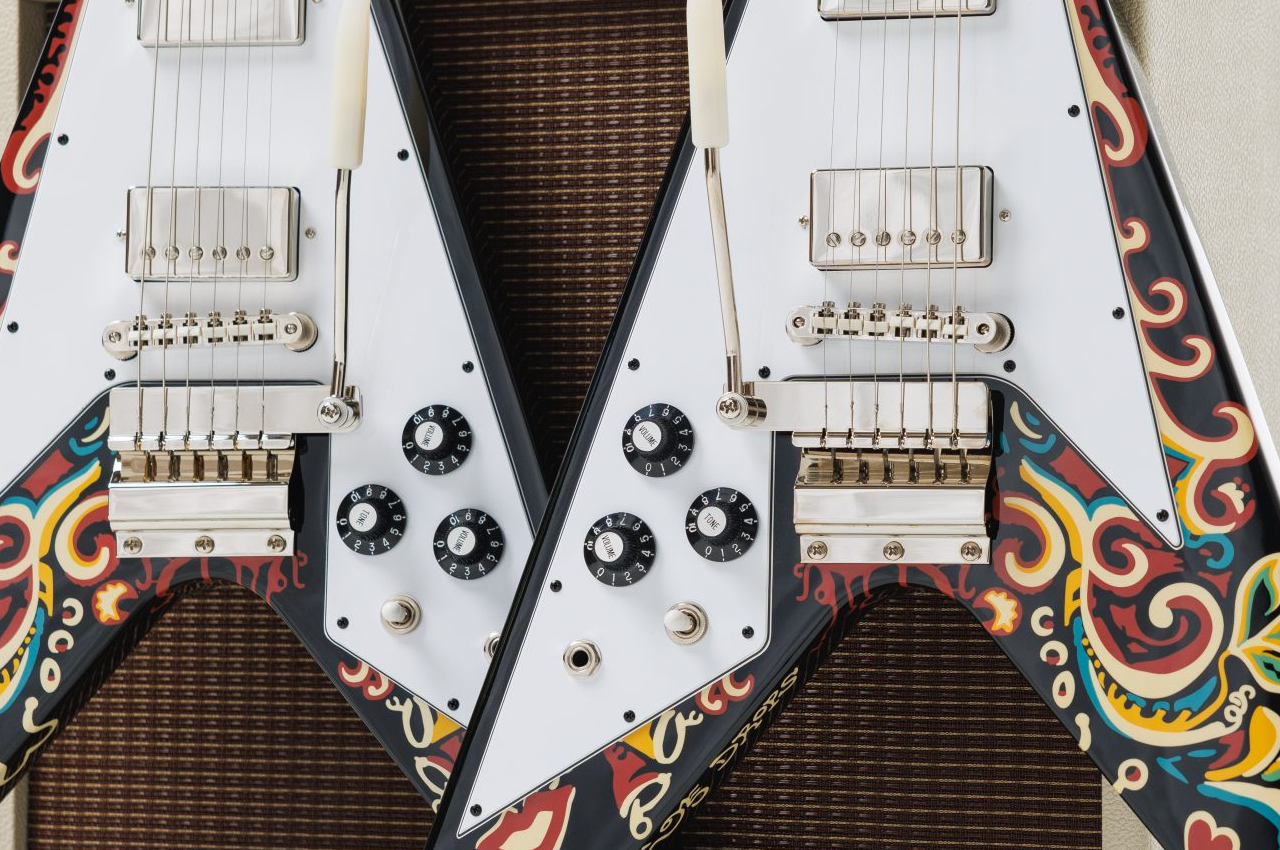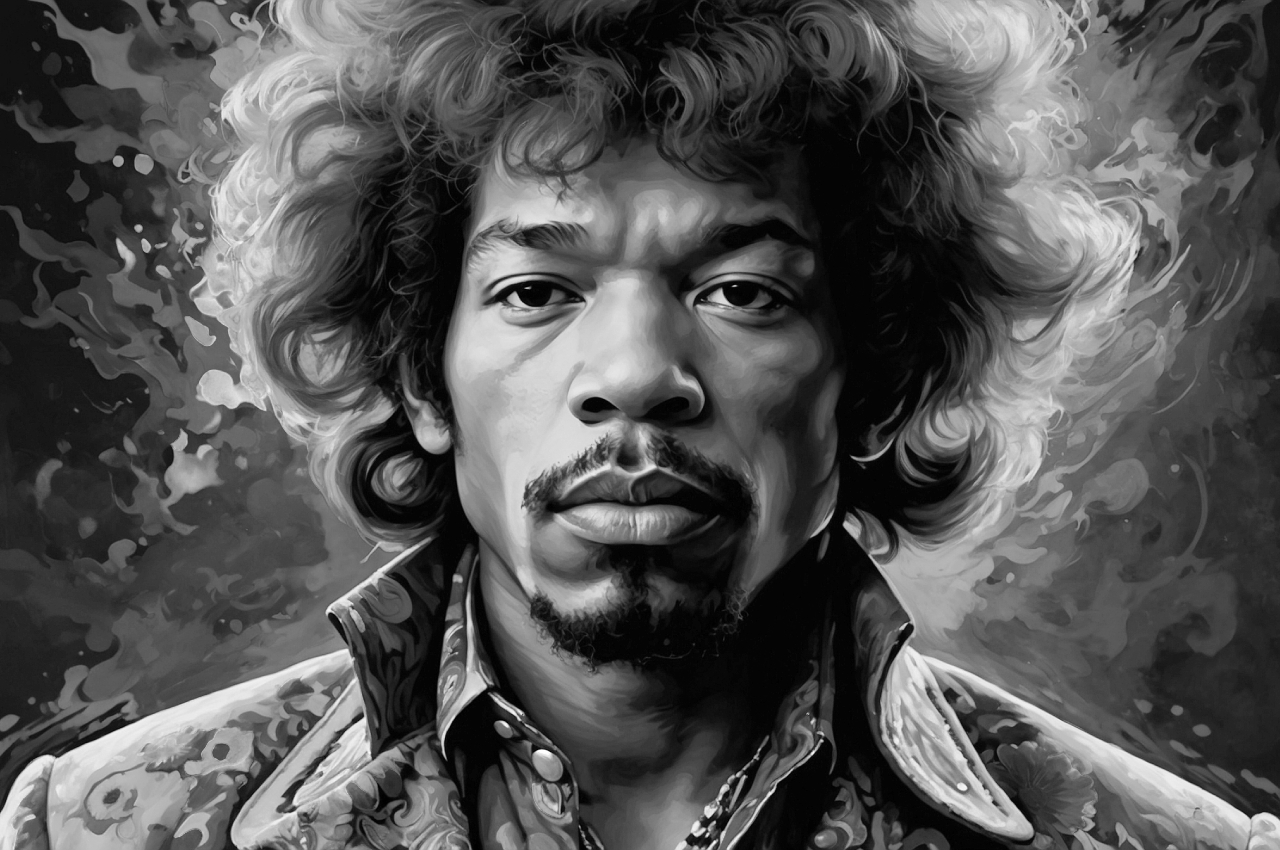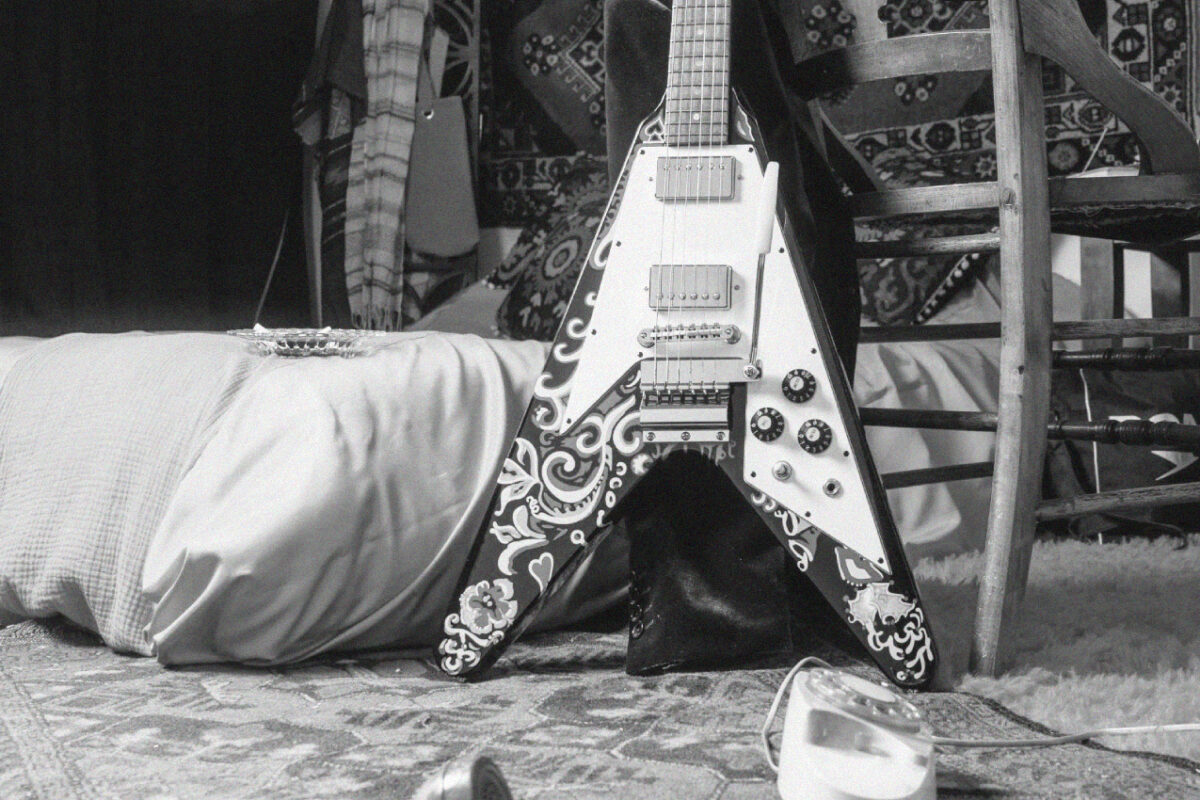The Epiphone Flying V is nothing short of an audacious masterpiece, an emblem of rebellion that changed the landscape of guitar design forever. Its origin story begins with Gibson’s daring move in the late 1950s, introducing a guitar that defied convention with its angular, futuristic silhouette. At first, the Flying V seemed too radical for the mainstream, too ahead of its time, but that’s precisely what made it irresistible to a certain breed of guitarist—the visionary, the nonconformist, the revolutionary.
Jimi Hendrix, the unparalleled force of nature in rock history, was drawn to the Flying V for exactly these reasons. By the late 1960s, Hendrix had shattered every boundary in music, and his Flying V became his weapon of choice, a guitar that screamed individuality, innovation, and sonic supremacy. Hendrix wasn’t merely playing the Flying V; he was channeling its otherworldly energy into his iconic performances, etching his place in rock immortality.
Hendrix’s Personal Touch: The Hand-Painted Flying V
What elevated Hendrix’s Flying V beyond a mere instrument was his artistic genius that extended far beyond sound. He transformed his Flying V into a literal work of art, hand-painting it with mesmerizing, psychedelic designs that captured the very essence of the 1960s counterculture. This was not just paint on wood; it was an explosion of color, a visual symphony that reflected the societal upheavals, the revolutionary spirit, and the awakening consciousness of the time.
Hendrix’s hand-painted Flying V was more than an aesthetic statement. It was deeply personal, brimming with symbolic meaning. His vibrant use of swirling patterns, bold colors, and abstract shapes made the guitar an extension of his soul. Every brushstroke felt like an act of defiance, an emotional outcry, a declaration of his boundless creativity. It wasn’t just a guitar—it was a manifestation of freedom, passion, and artistic audacity. In a world where conformity was the norm, Hendrix’s Flying V stood as an electrifying symbol of resistance.

Epiphone’s Loving Recreation: Honoring Hendrix’s Vision
In recreating Hendrix’s legendary Flying V, Epiphone embarked on an extraordinary mission—to honor not just a guitar, but the very spirit of Jimi Hendrix himself. This was no ordinary tribute; it was a painstakingly crafted homage, a labor of love to capture every nuance, every detail, of Hendrix’s iconic hand-painted instrument.
The Epiphone Jimi Hendrix “Love Drops” Flying V™ is inspired by a guitar that Hendrix played extensively from 1967-69, and is a meticulously crafted instrument that reflects Hendrix’s unique style and personality. Originally a Sunburst model, Hendrix personally customized his Flying V with hand-painted psychedelic graphics after first refinishing it in Ebony. This new release faithfully recreates that iconic design, making it a must-have for fans and collectors alike.
Epiphone’s luthiers spared no effort in resurrecting the intricate patterns and vivid colors of Hendrix’s original design. They meticulously studied every inch of the original guitar to ensure that the modern recreation was nothing less than an exact replica. This level of craftsmanship is unparalleled, blending old-world artistry with state-of-the-art precision to breathe life into this guitar. The meticulous attention to detail extends to the body, neck, and fretboard, all painstakingly recreated to Hendrix’s exact specifications.
But the recreation isn’t merely about aesthetics—it’s about soul. Epiphone’s tribute to Hendrix preserves the authenticity of an instrument that helped define one of the most electrifying chapters in rock history.
The Sound of a Legend: Capturing Hendrix’s Tone
For Hendrix, the Flying V wasn’t just a visual marvel; it was an instrument of unmatched sonic potential. Epiphone has channeled this legendary sound into their recreation, ensuring it delivers the same jaw-dropping tones that made Hendrix’s performances so unforgettable. Every note from this guitar reverberates with the passion, fury, and emotion that defined Hendrix’s revolutionary style.
The Epiphone Flying V is equipped with pickups and electronics engineered to replicate the searing highs, soulful mids, and growling lows of Hendrix’s original sound. These aren’t just tones—they’re echoes of history, reverberating with the fiery essence of the man who wielded this guitar like a thunderbolt. Whether you’re looking to channel the volcanic energy of Hendrix’s most explosive solos or the raw emotionality of his bluesy riffs, this guitar delivers in every respect. The combination of vintage sound with cutting-edge technology ensures that players today can experience the power of Hendrix’s tone with unparalleled authenticity.
Why was Hendrix so influential?
We love playing his songs on guitar, but why was he so revolutionary? Didn’t the Stones use distortion and effects years before him? Most of his songs only use the minor pentatonic scale or the blues scale…. what made him so revolutionary? Here on of the best answer by mugwampus.
Jimi Hendrix was a true enigma, a force of nature on the guitar, blending raw talent with relentless passion. Before stardom, he honed his craft in the gritty ‘chitlin circuit,’ playing alongside R&B legends like Wilson Pickett, King Curtis, and Little Richard. These experiences sharpened his precision and versatility, shaping his rhythmic prowess and flamboyant stage presence. His infamous behind-the-back, teeth, and between-the-legs guitar tricks weren’t just showmanship; they were a product of years spent perfecting his art.

Hendrix was more than just a performer—he was an obsessive student of music. He devoured every genre, from jazz to country, immersing himself in soundscapes far beyond rock. With his guitar never far from his side, he jammed with anyone and everyone, constantly absorbing and creating. Offstage, he was introverted, often retreating to the studio where he pushed the boundaries of distortion, feedback, and sonic experimentation. Always at the cutting edge, he embraced the technology of his era, relentlessly seeking new tones and textures.
What set Hendrix apart, even among the greats like Clapton, Page, and Beck, was not just his technical skill but his unparalleled ability to fuse emotion with sound. His guitar wasn’t just an instrument—it was an extension of his soul. Tracks like “Machine Gun” from “Band of Gypsys” are haunting testaments to his genius, where the guitar speaks—screaming with anguish, sorrow, and rage. His emotive power remains unmatched, transcending mere notes and scales to tap into the raw essence of human experience.
Though others may play faster, cleaner, or more complex, none could harness the guitar’s emotional potential like Hendrix. His mastery wasn’t just technical; it was spiritual. Hendrix wasn’t just a guitarist—he was a visionary, a sonic alchemist who turned sound into feeling, leaving a legacy no one has ever truly replicated.
A Guitar for the Ages: Why This Flying V Stands Out Today
In a sea of mass-produced instruments, Epiphone’s recreation of Hendrix’s Flying V is a beacon of craftsmanship, artistry, and soul. It is not merely a guitar; it is a time capsule, an artifact of rock ‘n’ roll history that connects modern musicians to the golden era of psychedelic rock. Yet, this is not an instrument frozen in time—it marries the vintage vibe with cutting-edge innovation, making it as relevant today as it was in the 1960s.
Epiphone’s recreation of Hendrix’s Flying V is a masterstroke—a loving tribute to a guitar that helped shape the very foundations of rock ‘n’ roll. It is an instrument that transcends time, a testament to the enduring power of music, artistry, and individuality.
Related Links:
Love Drops” Flying V™
The Influence of Jimi Hendrix and Other Legends

